Long ago, in a galaxy far away, I used to sew. Remnants of my avocation lay buried in my basement when the Centers for Disease Control made this announcement on Friday: Use of cloth face coverings can help slow the spread of the novel coronavirus known as Covid-19.
“Wondering if I’m up to this face mask thing,” I mused on Facebook. Within an hour, friends from various stages of my life offered encouraging words. And then, from across the continent and the Atlantic, my weekend turned into a virtual sewing bee that provided a welcome distraction from the news.
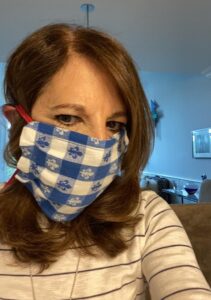
Toby Kramer Alfred
Toby Kramer Alfred, a high school classmate who is now a financial services consultant to senior executives, was the first to cheer me on. She posted a snapshot of a blue-and-white-checked picnic napkin that she had transformed into a mask. The ties were fashioned from red bias tape left over from a clown costume she made for one of her daughters more than 30 years ago. Having forsaken picnics, at least temporarily, Alfred stayed home in New York and used the set of napkins to make five more masks – one for each family member.
By Friday evening the subject of sewing face masks had proliferated, or, as we might have said in the B.C. (before Covid) era, gone viral. Now that we understand how bad things can get, we are not using that metaphor quite so freely. Indeed, on the same day that face mask patterns were being widely shared and critiqued in cyberspace, New York, where I live, recorded its largest single-day death toll from the coronavirus.
A cloth face mask, according to the CDC pronouncement, won’t prevent us from catching the virus and suffering a similar fate. Its purpose, coupled with social distancing, is to deter us from transmitting it to others if we have the virus but are asymptomatic. As we say in New York, “I should be so lucky.”
With “stay home” orders here extended through the end of April, I don’t see much human contact in my immediate future. But during the occasional walk in the park or mission to procure essential goods, I want to be a responsibly attired citizen. So I went down to the basement and got out my old Singer sewing machine, Model number 457, which had been a gift for my 13th birthday. Let’s just say it’s decades old.
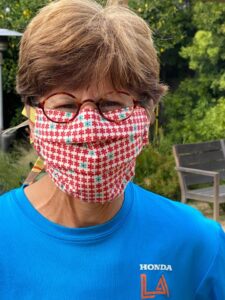
Amy Schaefer Martinez
Like many other baby boomers, I learned to thread the needle in junior high school, when the boys had shop class while the girls were assigned to make dirndl skirts that some of us actually wore. Later, I branched out and sewed my own clothes, gifts for friends, and ultimately for their children. The Singer got retired to the basement after I discovered the affordable luxury of custom-made clothing from Southeast Asia – an interest I pursued with a passion on many trips to that part of the world, most recently on the cusp of the pandemic.
The Singer was gathering dust in a storage cabinet, wedged behind the rarely used cross-country skis, beach umbrella and muck boots. My supplies, tucked away in a caddy on wheels, included about a yard of yellowing, quarter-inch wide elastic – perfect for face masks and therefore now in short supply; mine was left over from the days when I used it to make peasant blouses.
There was also enough thread to last several lifetimes, most of it neatly arranged in two 8-by-13-inch plastic boxes, with handles. These boxes, containing a total of about 60 spools, had belonged to my maternal grandmother, who died in 2002. I don’t recall how or why the boxes arrived at my house, but I have never been able to part with them. They are labeled in my grandmother’s handwriting: “Pastel & High Shades” and “Dark & Dull.”
She, too, had an old Singer in the basement. Hers looked like a piece of furniture, with an iron base, oak cabinet, and drawers full of thimbles and whimsical pincushions that I loved to rummage through when I was a child. But each time I asked Nanny, as I called her, to show me how it worked, she refused. “I don’t like to sew,” was all she would say, and divert my attention to another activity. Her reaction remained a mystery.
This weekend, as I sat in my basement sewing face masks for my family, I found a clue. Looking for a thread to match a mask that I was making, out of a plaid dish towel, I opened the box labeled “Dark & Dull.” It contained 11 spools of thread in a very drab green, nine in khaki or taupe, and another handful in a dark grayish blue. These were unmistakably the colors of uniforms – and lots of them.
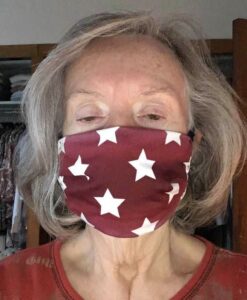
Dorothy Morehead
I knew that my grandmother had spent summers during the Great Depression employed as a counselor at the camps that her three children attended. She never told me, but the thread boxes suggested that, during these “dark and dull” times, she had also sewn uniforms for the family. And by the time it was over, understandably, she didn’t like to sew.
Now the “pastel and high shades” of my own life had turned dark and dull. Our country is in the middle of a pandemic, its economic future uncertain. And none of us is sure how long the current confinement will last.
My fingers are less nimble, threading the needle takes more effort, and my sewing skills are woefully stale. When the bobbin thread ran out, I couldn’t remember all the steps for rewinding it. But in the year 2020, it took only a few keystrokes on my computer to find a YouTube video on how to perform the function on my specific model.
As I was getting reacquainted with my Singer, friends, similarly quarantined, were having a parallel experience. “I worked in fits and starts until I recalled all the steps,” wrote Amy Schaefer Martinez, an audiologist in Los Angeles, who has been a quilting hobbyist on and off, most recently to sew baby gifts for younger colleagues. “There’s nothing quite like the feeling of feeding fabric across the presser foot.”
Dorothy Morehead, a real estate agent in Sunnyside, New York, didn’t have a sewing machine, so she spent five hours fashioning a mask by hand, from an old pair of American Eagle men’s boxer shorts. “I have no idea where they came from,” says Morehead, of the red boxers patterned with big white stars. “I’m guessing a young man who lived here years ago. I was going through a container of clothes in my basement and found them.”
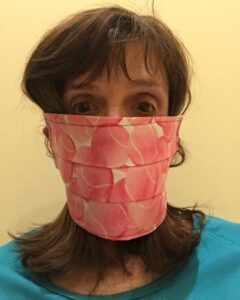
Darlene Eisenstein
Darlene Eisenstein, a onetime home economics teacher now retired in Boca Raton, Florida, took scraps from various Halloween costumes she sewed and turned them into masks. If she decides to wear that flapper outfit, made of a pink tennis ball print, again, she’ll have a mask to match. She plans to sew about ten extras, to give to friends in the community. The only impediment, she said in a text, is “I am low on elastic. Using the elastic from the sleep masks they give out on airplanes.”
En route to the Saturday Green Market in our neighborhood, my husband and I took photos of our new threads to send to Laurence Chambon, a French friend. Nous avons la même occupation! (“We’re doing the same thing!”) she texted back, from her own confinement, in the one-street village of Sare, at the foot of the Pyrenees in southwest France. Then she sent a photo with her daughter Pauline, of the two of them wearing what were by far the most stylish and well designed homemade masks I have seen so far.
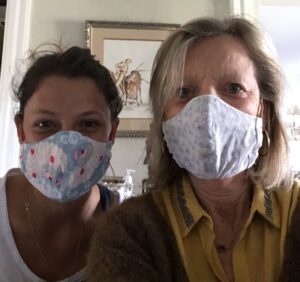
Pauline and Laurence Chambon
An architect and interior designer, Chambon is no stranger to the sewing machine, having made all the upholstery and draperies in her home. (We spent six weeks, in 2015, living in the Airbnb apartment she operates there.) I didn’t have the vocabulary to tell her colloquially that her masks put all of ours to shame, but she seemed to get the idea.
Le tout c’est de les faire, she demurred, with all the grace and diplomacy one might observe at an in-person sewing bee. “The whole thing is to make them.”
Deborah L. Jacobs, a lawyer and journalist, is the author of Estate Planning Smarts: A Practical, User-Friendly, Action-Oriented Guide. To purchase the book at a 15 percent discount, order it here and, once it is in your shopping cart, enter the promo code COVID19.
RELATED POSTS
How to Borrow E-books and Audiobooks from the Library
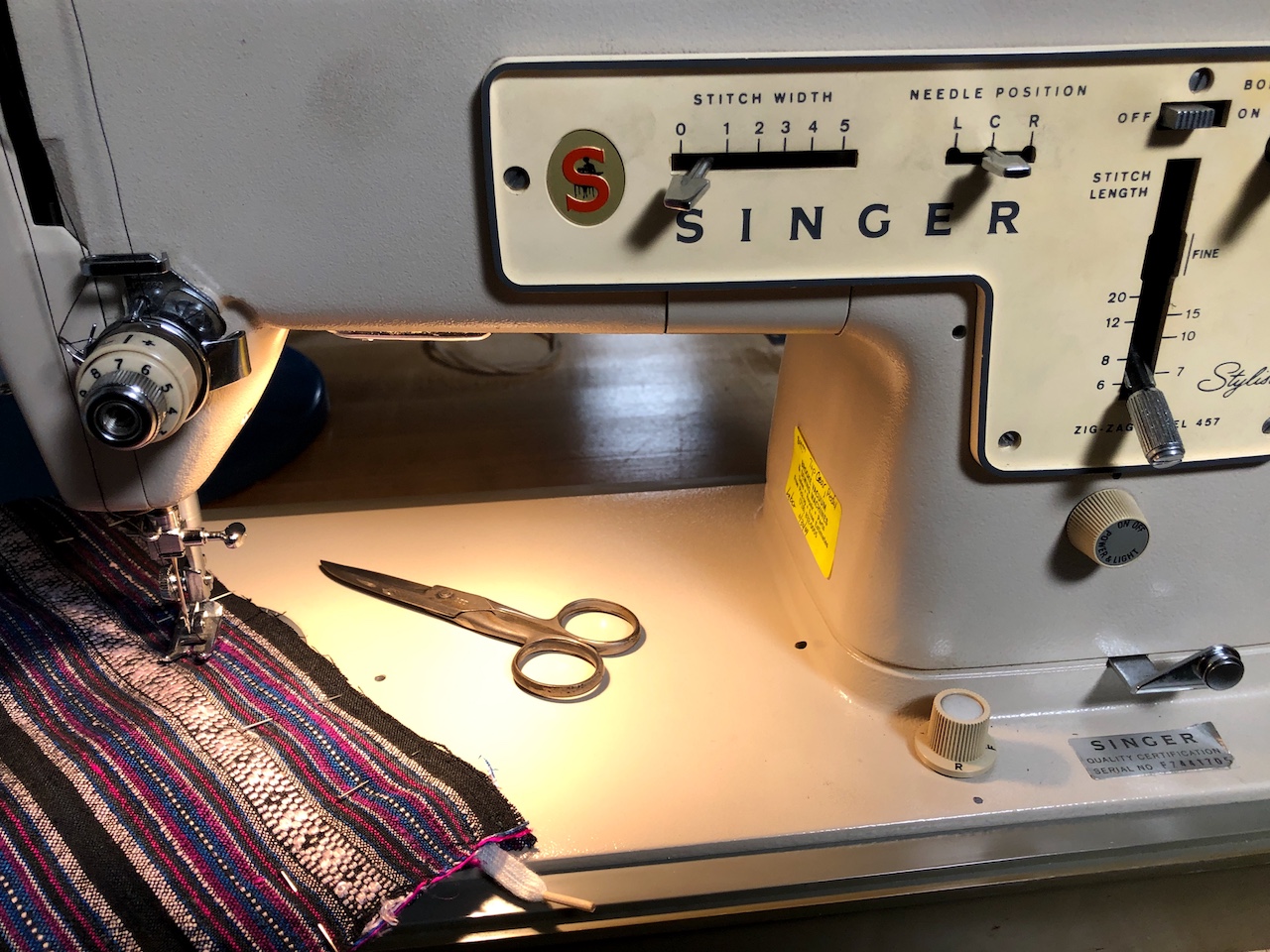 Retrieved from a basement storage closet, a decades-old work horse gets dusted off and drafted for a new challenge.
Retrieved from a basement storage closet, a decades-old work horse gets dusted off and drafted for a new challenge.
Great article, particularly for us baby boomers who have a history of good cause activity. I think this is a great mental health activity. I am very skeptical about the physical health benefits. But it doesn’t hurt and it keeps peoples spirits up. Good girls.